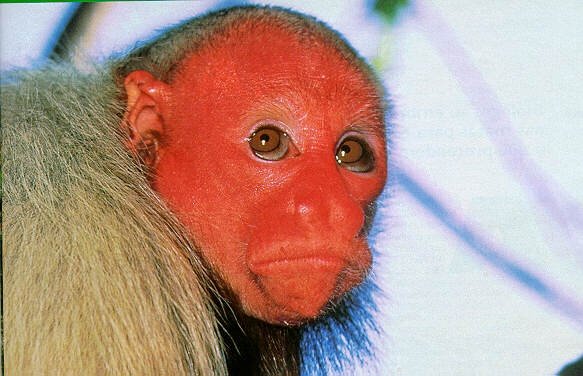
In many ways, the Uakari symbolizes the mysteries of the Amazon rainforest, a lush world filled with vibrant life and rich traditions. Imagine sitting down with a cup of coffee, discussing how different cultures interpret nature’s wonders. The Uakari stands out as a creature that embodies local legends while shining a spotlight on environmental issues. Its representation in culture and folklore is a window into how communities honor and respect their natural surroundings.
The Uakari: An Overview
The Uakari belongs to the genus Cacajao and is known for its distinctive features. These primates are primarily found in the flooded forests of the Amazon Basin, where their striking red faces and short tails make them easily recognizable. Their unique physical traits are not just for show; they play a crucial role in their survival and social interactions.
Social Structure: Uakaris are highly social animals. They live in groups, often consisting of several males and females. This social structure helps them find food and stay safe from predators. Watching them interact is like viewing a dynamic community where communication and cooperation are key.
Diet and Habitat: Their diet mainly consists of fruits, seeds, and nuts, which they find among the trees. This reliance on a diverse diet highlights the importance of the rainforest ecosystem. Unfortunately, habitat loss due to deforestation poses a significant threat to their survival. It’s a stark reminder of how intertwined our existence is with that of these remarkable creatures.
Folklore and Mythology Surrounding the Uakari
Folklore often paints a vivid picture of how cultures view animals, and the Uakari is no exception. In various Amazonian cultures, it’s common to find stories featuring this primate, which often symbolize traits such as mischief or wisdom.
Trickster Tales: Many local legends depict the Uakari as a mischievous character. These stories often involve the Uakari outsmarting other animals or even humans, showcasing its intelligence and adaptability. This trickster image teaches important life lessons about cunning and the importance of wit.
Symbol of Wisdom: In some tribes, the Uakari represents wisdom due to its cleverness and social nature. Tales of the Uakari sharing knowledge or guiding other animals often serve to instill respect for the natural world. These stories are not just entertaining; they carry valuable teachings passed down through generations.
The Role of the Uakari in Indigenous Cultures
Understanding how the Uakari fits into indigenous lifestyles can help us appreciate its importance. For many tribes of the Amazon, the Uakari is more than just an animal; it’s part of their identity and a symbol of their connection to nature.
Rituals and Traditions: Some cultures include the Uakari in their rituals, celebrating its essence in dance, art, and storytelling. This incorporation highlights the respect and reverence these communities have for the Uakari and its habitat.
Environmental Stewardship: The presence of the Uakari in cultural practices also underscores the importance of wildlife conservation. Many tribes advocate for the preservation of their natural environment, recognizing that the survival of the Uakari is tied to the health of the rainforest itself.
Art and the Uakari: A Cultural Representation
Art often serves as a reflection of cultural values and beliefs, and the Uakari has inspired a variety of artistic expressions. From sculptures to paintings, this primate appears in numerous forms, showcasing its significance in local culture.
Sculptures and Crafts: Many artisans create intricate sculptures of the Uakari, often using materials found in the rainforest. These artworks not only celebrate the beauty of the animal but also highlight the skills and creativity of the local artisans.
Paintings and Murals: The Uakari’s striking appearance makes it a popular subject in murals and paintings. These artworks often aim to tell stories about the Uakari and its role in the ecosystem, blending aesthetic beauty with cultural significance.
Modern Interpretations and Conservation Efforts
In recent years, the Uakari has gained attention from conservationists and researchers alike, leading to increased awareness of its plight. As concerns about habitat loss grow, modern interpretations of the Uakari’s role in culture reflect a shift towards conservation and sustainability.
Ecotourism: The rise of ecotourism has brought more visitors to the Amazon, where they can learn about the Uakari and its habitat. This increased interest often supports local economies while emphasizing the need for environmental protection.
Conservation Campaigns: Several organizations are working to protect the Uakari’s natural habitat, focusing on educating communities about the importance of conservation. These campaigns often incorporate cultural elements, creating a deeper connection between the Uakari and the people working to save it.
The Uakari is more than just a fascinating animal; it’s a symbol of cultural richness and environmental importance. Its representation in folklore and art speaks to the deep connections humans have with nature.
As we learn about the Uakari, we gain insights into not just its world, but also our responsibility to protect it. By celebrating the Uakari’s cultural legacy, we can contribute to a future where this remarkable primate continues to thrive in the wild. So, the next time you think about the Amazon rainforest, remember the Uakari—not just as an animal, but as a bridge between humanity and the natural world.
